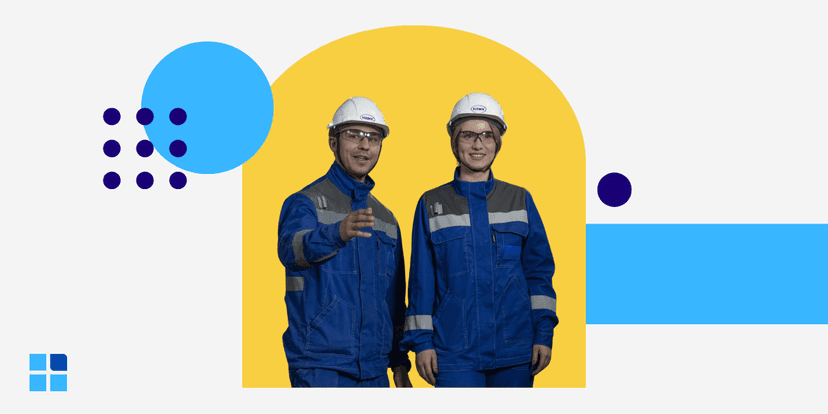In any manufacturing operation, there's always one process, one machine, or one policy that holds everything back. You can feel it when work piles up in one area while another sits idle. This bottleneck, or limiting factor, dictates the pace of your entire operation. The theory of constraints is a powerful project management and continuous improvement methodology that provides a laser-focused approach to managing these bottlenecks.
Instead of trying to improve everything at once, the theory of constraints argues that every complex system, including a manufacturing process, has at least one constraint. Therefore, the performance of the entire system is dictated by the performance of that single weakest link.
This guide provides an in-depth look at the theory of constraints. We will explore its core concepts, its powerful focusing steps, and the tools you need to identify and manage the system constraints that are holding you back from achieving true operational excellence.
What is the theory of constraints?
The theory of constraints (TOC) is a lean management philosophy introduced by Dr. Eliyahu M. Goldratt in his 1984 novel, "The Goal." At its core, the theory of constraints states that the output of any system is limited by at least one constraint. This single limiting factor determines the maximum system performance.
Think of your production line as a chain. The entire system is only as strong as its weakest link. If you strengthen any link other than the weakest one, you haven't made the chain any stronger. You've just wasted resources.
This is the essence of constraints theory. It provides a set of tools for identifying this weakest link and then managing your operations around it to maximize throughput. These constraints often lead to bottlenecks that can hinder project success. The theory of constraints provides a powerful framework for focusing improvement efforts exactly where they will have the greatest impact on the overall system performance.
The goal how the system generates money
The primary goal of the theory of constraints is to increase throughput. In lean manufacturing, we often focus on eliminating waste, but the theory of constraints reframes success through a financial lens called throughput accounting.
Throughput accounting simplifies operational metrics into three key measurements:
- Throughput (T): The rate at which the system generates money through sales. This is not the production rate; it's the rate of sold product.
- Inventory (I): All the money the system has invested in purchasing things it intends to sell. For instance, this includes raw materials, facilities, and equipment.
- Operating expense (OE): All the money the system spends to turn inventory into throughput. This includes labour, utilities, and other overhead costs.
This model differs significantly from traditional accounting. In traditional accounting, inventory is often considered an asset, which can drive undesirable behaviours like accumulating excess inventory to make financial reports look better.
Throughput accounting, however, considers inventory to be a liability, as it ties up cash that could be used more productively elsewhere. Under this model, Net Profit is defined simply as Throughput minus Operating Expenses. Consequently, Return on Investment is calculated as Net Profit divided by Investment (Inventory).
From the perspective of the theory of constraints, the number one priority is to increase throughput. Reducing operating expense is secondary, and reducing inventory is third. This is because eliminating waste at a non-constraint process doesn't make the entire system more money, but improving constraint performance does.
The five focusing steps of the theory of constraints
The theory of constraints uses a cyclical process of continuous improvement known as the five focusing steps. The TOC philosophy suggests that you should implement a continuous flow of improvement by addressing system constraints sequentially.

1. Identify the system's constraint
Identifying the constraint is the first step in any implementation of TOC methodologies. In a manufacturing process, this is often the machine or workstation on the production line with the longest cycle times or the most inventory piled up in front of it.
You can use value stream mapping or simply observe the shop floor to find this limiting factor. It could be a physical machine, a lack of skilled people, or even a company policy.
2. Exploit the system's constraint
The second step involves exploiting the constraint to maximize its throughput using only existing resources. Once you identify the constraint, the goal is to get the absolute most out of it without spending significant money.
- Run it during breaks and lunches.
- Ensure it only works on high-quality parts so its time isn't wasted.
- Perform preventive maintenance outside of scheduled production hours.
This step is all about maximizing the constraint performance with the resources you already have.
3. Subordinate everything else
This is the most transformative step in the theory of constraints. It means that every other part of the manufacturing process (the non-constraints) must be adjusted to support the constraint.
If the constraint can only produce 100 units per hour, the preceding steps must not produce 150 units per hour. This "subordination" starves non-constraint processes, which feels inefficient but is correct. It prevents excess inventory (Muda) and focuses the entire system on the constraint's pace.
4. Elevate the system's constraint
If steps 2 and 3 are not enough to meet demand, you must "elevate" the constraint. This is the step where you finally spend money.
- Buy a second machine.
- Hire more people for the constraint-heavy task.
- Redesign the product to require less time at the constraint.
Elevating the constraint is the last resort because it often involves significant operating expense.
5. Repeat the process
The final step in the five focusing steps is to repeat the process continuously. As soon as you successfully elevate a constraint, it may no longer be the bottleneck. Another part of the system will become the new constraint. The theory of constraints is a cycle of continuous improvement. You immediately go back to Step 1 to identify the new weakest link.
Examples of constraints in manufacturing project management
While we often think of constraints as physical machines, they can take many forms, especially in project management and continuous improvement initiatives.
- Equipment constraints: A specific machine on the production line that is slower than all other steps (e.g., an aging CNC machine, a specialized testing rig).
- Resource (people) constraints: A lack of skilled personnel. For example, if you only have one certified welder, their availability is the limiting factor for all projects requiring that skill.
- Policy constraints: A company rule or procedure that slows down the entire system. This could be a complex approval process for ordering new parts or a rigid production schedule that doesn't align with customer demand.
- Market constraints: The constraint is external. Your system can produce more than the market is willing to buy. In this case, the theory of constraints would focus on marketing and sales to increase throughput.
- Supplier constraints: A key part of your supply chain management is the weakest link. If a supplier consistently delivers late, they become your system's constraint, regardless of how fast your production line can run.
Key tools used in the theory of constraints
To implement the five focusing steps, the theory of constraints employs several key tools and concepts. These tools help teams manage the flow of work and identify the root causes of problems.
Drum buffer rope (DBR)
Drum buffer rope (DBR) is the scheduling and execution methodology of the theory of constraints. It’s a pull system intended to align operations with the existing constraints.
- Drum: This is the constraint itself. Its production rate sets the "beat" or tempo for the entire production line.
- Buffer: This is a small, strategic amount of inventory placed immediately before the constraint. It acts as a shock absorber, ensuring that the constraint never starves for work due to problems at upstream processes.
- Rope: This is the communication signal that "pulls" new work into the system. It connects the constraint to the first operation, telling it when to release the next batch of materials, based on the buffer's status.
The thinking processes
The thinking processes are a set of logic-based tools used for project management within the theory of constraints. They help teams identify root causes and plan effective solutions.
- Current reality tree (CRT): A diagram used to map all undesirable effects (symptoms) in a system down to a single core problem or root causes.
- Future reality tree (FRT): A tool used to visualize a proposed solution and its positive effects. It helps teams validate an idea before implementation, ensuring it doesn't create new problems.
- Prerequisite tree (PRT): A diagram that identifies all the obstacles to implementing a solution and arranges them in a logical sequence of intermediate objectives.
Theory of constraints vs. lean manufacturing
A common question is how the theory of constraints differs from lean manufacturing. While both are continuous improvement philosophies, they have different points of focus.
Both lean manufacturing and the theory of constraints have a strong customer focus in their methodologies. They also both promote heavy employee involvement in identifying and resolving inefficiencies. However, their core approaches diverge.
Lean manufacturing, which grew from the Toyota Production System, focuses on eliminating waste (Muda) from the entire system. Lean seeks to eliminate all sources of variation. It uses tools like value stream mapping to identify and remove all non-value-added activities, with the goal of creating a continuous flow.
The theory of constraints, on the other hand, argues that eliminating waste at a non-constraint process is a waste of time. It doesn't improve overall system performance or help the system generates money. TOC often emphasizes maintaining a level of excess capacity for non-constraints, which is a different approach than Lean's.
The two philosophies work best together. The theory of constraints tells you where to focus your focusing improvement efforts (the constraint). Lean tools and principles provide the how for improving that specific constraint.
A practical manufacturing example of the theory of constraint
Let's walk through a simplified example of the theory of constraints on a production line that has four steps: Cutting, Welding, Painting, and Assembly.
Step 1: Identify the constraint
- The team observes the line and sees a massive pile of parts building up in front of the Painting booth. Parts are flowing quickly through Cutting and Welding, but the paint process is slow. The Painting booth is the limiting factor.
Step 2: Exploit the constraint
- The plant manager declares that the Painting booth must never be idle.
- They schedule operators to run the booth during normal lunch breaks (and pay them overtime).
- They add a quality check before painting to ensure the constraint's time isn't wasted on bad parts. This immediately improves constraint performance.
Step 3: Subordinate everything else
- The drum buffer rope system is implemented. The paint booth's pace is the "Drum."
- The Cutting and Welding supervisors are ordered to slow down. They are now only allowed to start a new job based on the "Rope" signal, which is tied to the rate that parts leave the painting "Buffer."
- This feels wrong to the Cutting and Welding supervisors, whose efficiency metrics drop, but the overall system performance improves.
Step 4: Elevate the constraint
- After three months, the company's sales increase, and the exploited paint booth still can't keep up.
- Management approves the purchase of a new, high-speed robotic painting system. This elevates the constraint.
Step 5: Repeat the process
- Six weeks after the new paint system is installed, work is now piling up in front of Assembly. Assembly has become the new weakest link.
- The theory of constraints cycle begins all over again.
Benefits of applying the theory of constraints
When an organization successfully implements the theory of constraints, the results can be transformative. The benefits go far beyond the production line.

- Increased process throughput: By focusing all efforts on the constraint, you directly increase the amount of product the entire system can sell.
- Reduced lead times: The drum buffer rope system and focus on flow dramatically cut the time it takes for an order to move through the manufacturing process.
- Lowered operating expense: By subordinating non-constraints, you stop overproduction, which reduces costs tied to excess inventory, scrap, and unnecessary work.
- Streamlined workflows: The theory of constraints can help teams streamline workflows and enhance collaboration within project management by making priorities clear.
- Improved on-time delivery: A predictable system based on the constraint's "drum" beat leads to more accurate and reliable delivery promises, boosting customer satisfaction.
- Better supply chain management: A smoother, more predictable flow simplifies materials management and reduces the chaos often found in the supply chain.
FAQ about the theory of constraints
Q1: What is a constraint?
A constraint is anything that limits a system from achieving its goal. In manufacturing, this is often a physical machine or resource, but it can also be a policy (e.g., a batching rule), a person (e.g., a single skilled inspector), or even market demand. It is the weakest link.
Q2: Is the theory of constraints only for manufacturing?
No. While it was born in manufacturing, the theory of constraints is a universal project management methodology. It can be applied to administrative processes, logistics, supply chain management, healthcare, and software development.
Q3: What is throughput accounting?
It is a simplified management accounting method that prioritizes throughput over traditional cost-accounting metrics. It argues that most costs (like labour) are fixed operating expense, and the best way to improve profitability is to maximize throughput, not to cut costs at non-constraints.
Q4: How does theory of constraints relate to Six Sigma?
They are highly complementary. The theory of constraints is excellent at identifying the one place in the process where improvement will make the biggest difference. Six Sigma provides a rigorous set of statistical tools to improve the quality, consistency, and constraint performance of that specific process.
Start focusing your improvement efforts today
In conclusion, the theory of constraints is a powerful lean management philosophy that provides clarity and focus. It moves organizations away from the chaotic and often wasteful effort of trying to improve everything at once. By focusing improvement efforts on the single weakest link, you can achieve rapid and significant gains in overall system performance.
Identifying the constraint with the theory of constraints is just the first step. The next, and most critical, part is managing the continuous improvement cycle. LeanSuite's Kaizen and Project Management System is the perfect tool for this. It is designed to help you manage the projects that arise from your theory of constraints analysis. Whether you are documenting the five focusing steps, managing a drum buffer rope implementation, or tracking a project to elevate a constraint, our system helps you implement more improvements faster, turning your insights into tangible, sustainable gains.







